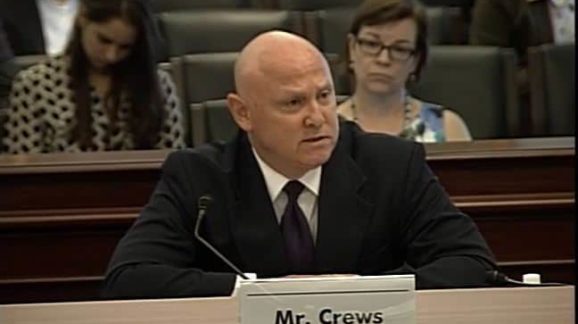Testimony on Regulatory Budgeting before the House Budget Committee

Today, the U.S. House of Representatives Budget Committee conducted a hearing on An Introduction to Regulatory Budgeting, and I was invited to testify by Chairman Tom Price (R-GA).
Yesterday I testified in the House Judiciary Committee on Office of Management and Budget review of regulations (which I’ll post next week), and last week in a Senate Homeland Security Subcommittee on federal agencies overusing “guidance documents.”
My written testimony from today on An Introduction to Regulatory Budgeting is here; below are my five-minute oral remarks:
I am Wayne Crews, vice president for Policy at the Competitive Enterprise Institute, a libertarian public policy and advocacy group, and I thank the committee for the invitation to address regulatory budgeting.
The federal government doesn’t merely spend nearly $4 trillion a year, it directs the private sector to spend colossal sums and otherwise re-purposes vast resources. Accordingly, the concept of a “regulatory budget” sometimes gains currency, such as the Fiscal Year 2017 Budget Resolution’s “Policy Statement on Federal Regulatory Budgeting.”
That regulatory costs rival a sizable percentage of the level of government spending itself argues for bipartisan scorekeeping. But here’s the thing:
Nobody sees the same rainbow (it’s true, you can look that up), and nobody necessarily sees the same cost and benefit of any given regulation.
So let us commence the case for budgeting federal regulations by recognizing that, some compliance burdens aside, perfectly tabulating subjective and indirect costs is impossible.
That said, try we must. Even if Washington collected a tiny percentage of Americans’ incomes in taxes, we would still monitor taxation to prevent its abuse.
Current disclosure is worrisome. Members may have noticed the White House Office of Management and Budget’s 2016 Report to Congress on the Costs and Benefits of Federal Regulations is overdue, putting us almost two years behind on regulatory cost/benefit data.
Moreover we should pay attention to unmeasured categories of intervention as cost drivers, such as antitrust, the locking up of western lands from resource use, the reluctance since the 1890s to move spectrum and other commons into the wealth creating sector, and more.
When government steers in some area of practical endeavor it creates costs even if no future rules are issued, such as federal government’s delivery of the Internet, and as of two weeks ago, drones, into century old public-utility models.
Furthermore the proliferation of agency guidance, or what I’ve taken to calling “regulatory dark matter,” will complicate budgeting efforts.
We confront this, though, in an environment in which cost-benefit analysis is largely absent. The latest-ever 2015 OMB report showed just 13 rules out of thousands with reviewed cost-benefit analysis; and independent agencies and guidance get a pass.
The concept of budgeting is not new, nor partisan. Democratic Texas Sen. Lloyd Bentsen, who served as Treasury Secretary in the Clinton Administration, proposed in the 1979 Disco era an “an annual cap on the compliance costs each agency could impose on the private sector” plus “coordinat[ing] the regulatory and fiscal budgets.” That’s important when considering dynamic scoring, and recognizing regulations affect macroeconomic variables.
Regulatory budgeting was also considered in President Jimmy Carter's 1980 Economic Report of the President.
Recent offerings include Sen. Marco Rubio’s “National Regulatory Budget,” and Sen. Mike Lee’s and Rep. Mark Walker’s “Article I Regulatory Budget Act.” Also, the June House “Economy” Task Force suggested a regulatory budget.
A comprehensive regulatory budget paralleling the fiscal one would presumably require Congress to divide a total among agencies roughly in proportion to potential lives saved or other key metrics. Agencies’ would rank concerns and address them within their budget constraint. While agencies could regulate unwisely, the squandered budgetary allocation could shift to a rival agency that saves more lives or performs some task better.
However, regulatory budgeting brings potential pitfalls and enforcement difficulties that I discuss in my written testimony. Ways to promote success include initiating an incremental rather than total budget, and build from there.
Establishing a regulatory cost freeze (a one-in, one-out approach like Democratic Sen. Mark Warner talked about) is the simplest regulatory “budget,” as it happens.
Implementing the bipartisan Regulatory Improvement Commission could help reduce the universe of matter you’re trying to deal with.
I highlight also the former Regulatory Program of the U.S. Government, a model by which OMB could compile an annual Regulatory Transparency Report with pre-budgetary matter paralleling the historical tables in the fiscal budget.
You could also employ separate budgets for economic, environmental, social, and safety regulation, plus paperwork.
So a cautious budget deserves consideration as Congress assumes greater accountability over the regulatory enterprise, and, it is my hope, reverses the over-delegation acknowledged in the recent Article I Task Force Report.
Like taxes, regulations transfer wealth from one party to another. So we could do far worse than cautious regulatory budgeting experiments within a broader framework of congressional accountability for both agencies’ regulations and guidance. In fact that’s what we do—far worse. Thank you very much.
More on regulatory reform here.